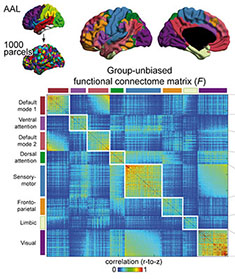Abstract
Neuroimaging studies have consistently shown distributed brain anomalies in epilepsy syndromes associated with a focal structural lesion, particularly mesiotemporal sclerosis. Conversely, a system-level approach to focal cortical dysplasia has been rarely considered, likely due to methodological difficulties in addressing variable location and topography. Given the known heterogeneity in focal cortical dysplasia histopathology, we hypothesized that lesional connectivity consists of subtypes with distinct structural signatures. Furthermore, in light of mounting evidence for focal anomalies impacting whole-brain systems, we postulated that patterns of focal cortical dysplasia connectivity may exert differential downstream effects on global network topology. We studied a cohort of patients with histologically verified focal cortical dysplasia type II (n = 27), and age- and sex-matched healthy controls (n = 34). We subdivided each lesion into similarly sized parcels and computed their connectivity to large-scale canonical functional networks (or communities). We then dichotomized connectivity profiles of lesional parcels into those belonging to the same functional community as the focal cortical dysplasia (intra-community) and those adhering to other communities (inter-community). Applying hierarchical clustering to community-reconfigured connectome profiles identified three lesional classes with distinct patterns of functional connectivity: decreased intra- and inter-community connectivity, a selective decrease in intra-community connectivity, and increased intra- as well as inter-community connectivity. Hypo-connectivity classes were mainly composed of focal cortical dysplasia type IIB, while the hyperconnected lesions were type IIA. With respect to whole-brain networks, patients with hypoconnected focal cortical dysplasia and marked structural damage showed only mild imbalances, while those with hyperconnected subtle lesions had more pronounced topological alterations. Correcting for interictal epileptic discharges did not impact connectivity patterns. Multivariate structural equation analysis provided a mechanistic model of such complex, diverging interactions, whereby the focal cortical dysplasia structural makeup shapes its functional connectivity, which in turn modulates whole-brain network topology.

